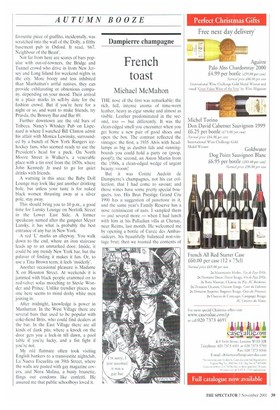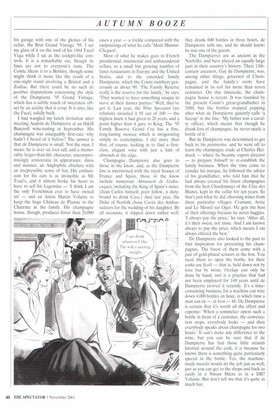French toast
Michael McMahon
THE nose of the first was remarkable: the rich, full, intense aroma of time-worn leather, heavy as cigar smoke and almost as visible. Leather predominated in the second, too — but differently. It was the clean-edged smell you encounter when you get home a new pair of good shoes and open the box. The contrast reflected the vintages: the first, a 1935 Alvis with headlamps as big as dustbin lids and runningboards you could hold a party on (poop, poop!); the second, an Aston Martin from the 1980s, a clean-edged wedge of urgent beauty: vroom!
But it was Comte Audoin tic Dampierre's champagnes, not his car collection, that I had come to savour; and those wines have some pretty special bouquets, too. His Brut Prestige Grand Cru 1990 has a suggestion of panettone in it, and the same year's Family Reserve has a nose reminiscent of nuts. I sampled them — and several more — when I had lunch with him at his Palladian villa at Chenay. near Reims, last month. He welcomed me by opening a bottle of Cuvee des Ambassadeurs, his beautifully balanced non-vintage brut; then we toasted the contents of
his garage with one of the glories of his cellar, the Brut Grand Vintage '95. I set my glass of it on the roof of his 1964 Facel Vega while I sat at the cockpit-like controls. It is a remarkable car, though its lines are not to everyone's taste. The Comte likens it to a Bentley, though some might think it more like the result of a one-night stand involving a Bristol and a Zodiac. But there could be no such de gust/bus disputations concerning the style of the Dampierre '95 Grand Vintage, which has a subtle touch of sweetness offset by an acidity that is crisp. It is also, like the Facel, solidly built.
I had wangled my lunch invitation after meeting Audoin de Dampierre at an H&H Bancroft wine-tasting in September. His champagne was unarguably first-rate: why hadn't I heard of it before? The answer is that de Dampierre is small, Not the man, I mean: he is over six foot tall, and a memorably larger-than-life character, uncompromisingly aristocratic in appearance, dress and manner, an Anglophile absolute with an irrepressible sense of fun. His enthusiasm for his cars is as invincible as Mr Toad's, and it almost broke his heart to have to sell his Lagondas — 'I think I am the only Frenchman ever to have owned six' — and an Aston Martin Volante to keep the huge Château de Plassac in the Charente in the family. His champagne house, though, produces fewer than 20,000 cases a year — a trickle compared with the outpourings of what he calls 'Moet-MummClicqua.
Most of what he makes goes to French presidential, ministerial and ambassadorial cellars, to a small but growing number of fancy restaurants in Europe and the United States, and to the extended family Dampierre, which the Count numbers generously at about 90. 'The Family Reserve really is the reserve for the family,' he says. 'They wanted to have something unique to serve at their dinner parties.' Well, they've got it. Last year, the Wine Spectator (no relation) awarded it 95 out of 100 — the highest mark it had given in 20 years, and a point higher than it gave to Krug. The '95 Family Reserve Grand Cru has a fine, long-lasting mousse which is invigorating simply to contemplate. I did more than that, of course, tucking in to find a firstclass, elegant wine with just a hint of almonds at the edge.
Champagne Dampierre also goes to those in the know, and, as the Dampierre line is intertwined with the royal houses of France and Spain, those in the know include numerous Almanach de Gothaesques, including the King of Spain's sister. (Juan Carlos himself, poor fellow, is dutybound to drink Cava.) And last year, the Duke of Norfolk chose Cuyee des Ambassadeurs for the wedding of his daughter. By all accounts, it slipped down rather well: they drank 600 bottles in three hours, de Dampierre tells me, and he should know; he was one of the guests.
The Damp ierres are as ancient as the Norfolks, and have played an equally large part in their country's history. Their 13thcentury ancestor, Guy de Dampierre, was, among other things, governor of Champagne, and the family's roots have remained in its soil for more than seven centuries. On this timescale, the champagne house is recent. It was founded by the present Count's great-grandfather in 1880, but the bottles stopped popping after what de Dampierre quaintly calls 'a hiccup' in the line: 'My father was a cavalry officer, which meant that though he drank lots of champagne, he never made a bottle of it.'
But de Dampierre was determined to get back to his patrimuine, and he went off to learn the champagne trade at Charles Heidseck — where he became export director — to prepare himself to re-establish the family business. When the time came to remake his marque, he followed the advice of his grandfather, who told him that he had always created his finest champagnes from the best Chardonnays of the Cote des Blanes, kept in the cellar for ten years. So that's just what he did, choosing wines from three particular villages: Cramant, Avize and Le Mesnil sur Oger. He gets the best of their offerings because he never haggles. 'I always pay the price,he says. 'After all, it's their sweat, not mine. And I am known always to pay the price, which means I am always offered the best.'
De Dampierre also looked to the past to find inspiration for presenting his champagnes. The finest of them come with a pair of gold-plated scissors in the box. You need them to open the bottle, for their corks are ficele — that is, held down not by wire but by twine. Ficelage can only be done by hand, and is a practice that had not been employed for 140 years until de Dampierre revived it recently. It's a timeconsuming business, for a machine can wire down 4,000 bottles an hour, in which time a man can tie — at best — 48. De Dampierre is certain that it's worth all the effort and expense: 'When a sommelier opens such a bottle in front of a customer, the conversation stops, everybody looks — and then everybody speaks about champagne for two hours.' It can't make any difference to the wine, but you can be sure that if de Dampierre has had those little strands knotted around the cork, it is because he knows there is something quite particularly special in the bottle. Yes, the machinemade muse/el would do the job just as well, just as you can get to the shops and back as easily in a Nissan Micra as in a DB7 Volante. But don't tell me that it's quite as much fun.



















































































 Previous page
Previous page